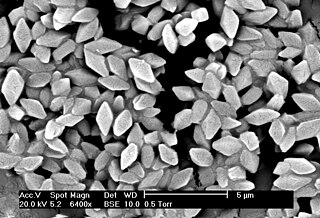
Bacillus thuringiensis is a Gram-positive, soil-dwelling bacterium, commonly used as a biological pesticide. B. thuringiensis also occurs naturally in the gut of caterpillars of various types of moths and butterflies, as well on leaf surfaces, aquatic environments, animal feces, insect-rich environments, and flour mills and grain-storage facilities. It has also been observed to parasitize other moths such as Cadra calidella—in laboratory experiments working with C. calidella, many of the moths were diseased due to this parasite.
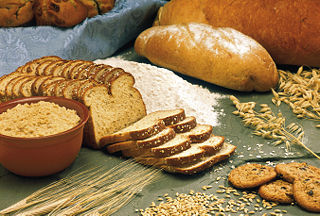
A cereal is any grass cultivated (grown) for the edible components of its grain, composed of the endosperm, germ, and bran. The term may also refer to the resulting grain itself. Cereal grain crops are grown in greater quantities and provide more food energy worldwide than any other type of crop and are therefore staple crops. Edible grains from other plant families, such as buckwheat (Polygonaceae), quinoa (Amaranthaceae) and chia (Lamiaceae), are referred to as pseudocereals.

Genetic engineering, also called genetic modification or genetic manipulation, is the direct manipulation of an organism's genes using biotechnology. It is a set of technologies used to change the genetic makeup of cells, including the transfer of genes within and across species boundaries to produce improved or novel organisms. New DNA is obtained by either isolating and copying the genetic material of interest using recombinant DNA methods or by artificially synthesising the DNA. A construct is usually created and used to insert this DNA into the host organism. The first recombinant DNA molecule was made by Paul Berg in 1972 by combining DNA from the monkey virus SV40 with the lambda virus. As well as inserting genes, the process can be used to remove, or "knock out", genes. The new DNA can be inserted randomly, or targeted to a specific part of the genome.

Wheat is a grass widely cultivated for its seed, a cereal grain which is a worldwide staple food. The many species of wheat together make up the genus Triticum; the most widely grown is common wheat. The archaeological record suggests that wheat was first cultivated in the regions of the Fertile Crescent around 9600 BCE. Botanically, the wheat kernel is a type of fruit called a caryopsis.

The chickpea or chick pea is an annual legume of the family Fabaceae, subfamily Faboideae. Its different types are variously known as gram or Bengal gram, garbanzo or garbanzo bean, or Egyptian pea. Chickpea seeds are high in protein. It is one of the earliest cultivated legumes, and 7500-year-old remains have been found in the Middle East.
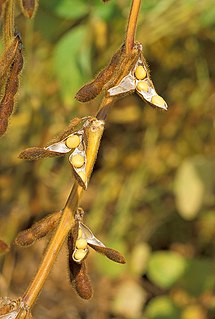
The soybean or soya bean is a species of legume native to East Asia, widely grown for its edible bean, which has numerous uses.

Agronomy is the science and technology of producing and using plants in agriculture for food, fuel, fiber, and land restoration. It is both a humanitarian career and a scientific one. Agronomy has come to encompass work in the areas of plant genetics, plant physiology, meteorology, and soil science. It is the application of a combination of sciences like biology, chemistry, economics, ecology, earth science, and genetics. Agronomists of today are involved with many issues, including producing food, creating healthier food, managing the environmental impact of agriculture, distribution of agriculture, and extracting energy from plants. Agronomists often specialise in areas such as crop rotation, irrigation and drainage, plant breeding, plant physiology, soil classification, soil fertility, weed control, and insect and pest control.

Genetically modified foods, also known as genetically engineered foods, or bioengineered foods are foods produced from organisms that have had changes introduced into their DNA using the methods of genetic engineering. Genetic engineering techniques allow for the introduction of new traits as well as greater control over traits when compared to previous methods, such as selective breeding and mutation breeding.
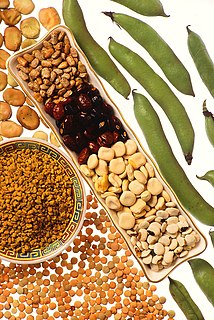
A legume is a plant in the family Fabaceae, or the fruit or seed of such a plant. The seed is also called a pulse. Legumes are grown agriculturally, primarily for human consumption, for livestock forage and silage, and as soil-enhancing green manure. Well-known legumes include alfalfa, clover, beans, peas, chickpeas, lentils, lupins, mesquite, carob, soybeans, peanuts, and tamarind. Legumes produce a botanically unique type of fruit – a simple dry fruit that develops from a simple carpel and usually dehisces on two sides.

The cowpea is an annual herbaceous legume from the genus Vigna. Due to its tolerance for sandy soil and low rainfall, it is an important crop in the semiarid regions across Africa and Asia. It requires very few inputs, as the plant's root nodules are able to fix atmospheric nitrogen, making it a valuable crop for resource-poor farmers and well-suited to intercropping with other crops. The whole plant is used as forage for animals, with its use as cattle feed likely responsible for its name.
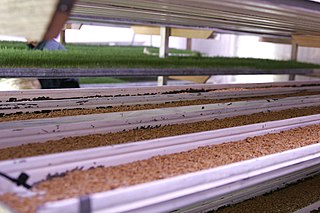
Fodder, also called provender, is any agricultural foodstuff used specifically to feed domesticated livestock, such as cattle, rabbits, sheep, horses, chickens and pigs. "Fodder" refers particularly to food given to the animals, rather than that which they forage for themselves. Fodder includes hay, straw, silage, compressed and pelleted feeds, oils and mixed rations, and sprouted grains and legumes. Most animal feed is from plants, but some manufacturers add ingredients to processed feeds that are of animal origin.

Vigna aconitifolia is a drought-resistant legume, commonly grown in arid and semi-arid regions of India. It is commonly called mat bean, moth bean, matki, Turkish gram or dew bean. The pods, sprouts and protein-rich seeds of this crop are commonly consumed in India. Moth bean can be grown on many soil types, and can also act as a pasture legume.
Agricultural chemistry is the study of chemistry, especially organic chemistry and biochemistry, as they relate to agriculture—agricultural production, the processing of raw products into foods and beverages, and environmental monitoring and remediation. These studies emphasize the relationships between plants, animals and bacteria and their environment. As a branch of agricultural science, agricultural chemistry studies the chemical compositions and reactions involved in the production, protection, and use of crops and livestock. Its basic science aspects embrace, in addition to test-tube chemistry, all the life processes through which humans obtain food and fiber for themselves and feed for their animals. Its applied science and technology aspects are directed toward control of those processes to increase yields, improve quality, and reduce costs. One important branch of it, chemurgy, is concerned chiefly with utilization of agricultural products as chemical raw materials.
The history of Agriculture in India dates back to Indus Valley Civilization and even before that in some places of Southern India. India ranks second worldwide in farm outputs. As per 2018, agriculture employed more than 50℅ of the Indian work force and contributed 17–18% to country's GDP.
Ice-minus bacteria is a common name given to a variant of the common bacterium Pseudomonas syringae. This strain of P. syringae lacks the ability to produce a certain surface protein, usually found on wild-type P. syringae. The "ice-plus" protein found on the outer bacterial cell wall acts as the nucleating centers for ice crystals. This facilitates ice formation, hence the designation "ice-plus". The ice-minus variant of P. syringae is a mutant, lacking the gene responsible for ice-nucleating surface protein production. This lack of surface protein provides a less favorable environment for ice formation. Both strains of P. syringae occur naturally, but recombinant DNA technology has allowed for the synthetic removal or alteration of specific genes, enabling the ice-minus strain to be created from the ice-plus strain in the lab.
Drought tolerance is the ability to which a plant maintains its biomass production during arid or drought conditions. Some plants are naturally adapted to dry conditions, surviving with protection mechanisms such as desiccation tolerance, detoxification, or repair of xylem embolism. Other plants, specifically crops like corn, wheat, and rice, have become increasingly tolerant to drought with new varieties created via genetic engineering.

A grain is a small, hard, dry seed, with or without an attached hull or fruit layer, harvested for human or animal consumption. A grain crop is a grain-producing plant. The two main types of commercial grain crops are cereals and legumes.

A staple food, food staple, or simply a staple, is a food that is eaten routinely and in such quantities that it constitutes a dominant portion of a standard diet for a given people, supplying a large fraction of energy needs and generally forming a significant proportion of the intake of other nutrients as well. A staple food of a specific society may be eaten as often as every day or every meal, and most people live on a diet based on just a small number of food staples. Specific staples vary from place to place, but typically are inexpensive or readily available foods that supply one or more of the macronutrients needed for survival and health: carbohydrates, proteins, fats, minerals, and vitamins. Typical examples include tubers and roots, grains, legumes, and seeds. Among them, cereals, legumes, tubers and roots account for about 90% of the world's food calories intake.
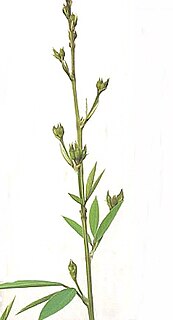
The pigeon pea, also known as pigeonpea, red gram, tur, pwa kongo in Haiti,, guandú and frijol de palo in Ibero-America, or as gungo peas in Jamaica, is a perennial legume from the family Fabaceae. Since its domestication in the Indian subcontinent at least 3,500 years ago, its seeds have become a common food in Asia, Africa, and Latin America. It is consumed on a large scale in South Asia and is a major source of protein for the population of the Indian subcontinent. It is the primary accompaniment to rice or roti and has the status of staple food throughout the length and breadth of India.

2016 was declared as the International Year of Pulses by the sixty eighth session of the United Nations General Assembly on December 20, 2013. The Food and Agriculture Organization (FAO) of the United Nations has been nominated to declare a year for pulses, more commonly known as legumes.














